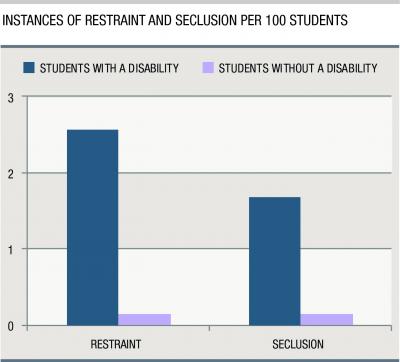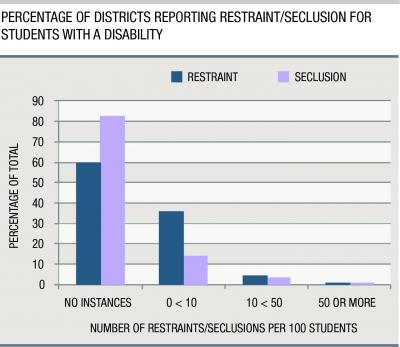Disabled Students: Restraint and Seclusion in Schools
Author: University of New Hampshire
Published: 2013/12/18 - Updated: 2021/03/01
Category Topic: Disability Education - Academic Publications
Page Content: Synopsis - Introduction - Main
Synopsis: Research by University of New Hampshire on variation in rates of restraint and seclusion among students with a disability. Seclusion is a practice that usually involves the involuntary isolation of a student for a period of several minutes.
Introduction
The restraint and seclusion of students in U.S. public schools in response to student behavior problems are used much more frequently on students with a disability than on students without a disability, and especially in affluent school districts, according to new research at the Carsey Institute at the University of New Hampshire.
Main Content
Restraint is a practice that uses physical or mechanical means to restrict a student's freedom of motion. Seclusion is a practice that usually involves the involuntary isolation of a student for a period of several minutes.
The research is presented in the Carsey Institute brief "Variation in rates of restraint and seclusion among students with a disability." The research was conducted by Douglas Gagnon, doctoral candidate in education at UNH and a research assistant at the Carsey Institute; Marybeth Mattingly, director of research on vulnerable families at the Carsey Institute and research assistant professor of sociology at UNH; and Vincent Connelly, associate professor of education at UNH.

On average across school districts nationwide, there were 2.6 instances of restraint for every 100 students with a disability for the 2009-2010 school year, compared with only 0.1 instances for every 100 students without a disability, the researchers found. Seclusion rates followed a similar pattern.
The researchers found there was wide variability in the use of restraint and seclusion on students with a disability in school districts, with the vast majority of school districts not employing these techniques. According to the researchers, 59.3 percent of school districts report no instances of restraint of a student with a disability and 82.5 percent do not report a single instance of seclusion. However, a small proportion of districts report exceedingly high rates.
"Schools today are tasked with implementing positive techniques that can effectively manage the difficult and sometimes violent behaviors of the most challenging students with a disability, which might lead some schools to more extreme measures," the researchers said.
The researchers also found that school districts with higher concentrations of poverty and larger black and Hispanic populations are associated with lower rates of restraint and seclusion. In fact, average rates of restraint and seclusion are more than twice as high in school districts of low poverty and low diversity.

"If certain disability types elicit more frequent restraint and seclusion, and the frequency of such disabilities differs by school type, this may help explain why rates differ across school poverty and racial composition," the researchers said.
This research is based on data from the 2009-2010 Civil Rights Data Collection and the 2009 Small Area Income and Poverty Estimates. The research brief "Variation in rates of restraint and seclusion among students with a disability" is available at carseyinstitute.unh.edu/publication/969.
The Carsey Institute conducts policy research on vulnerable children, youth, and families and on sustainable community development. The institute gives policy makers and practitioners the timely, independent resources they need to effect change in their communities.
The University of New Hampshire, founded in 1866, is a world-class public research university with the feel of a New England liberal arts college. A land, sea, and space-grant university, UNH is the state's flagship public institution, enrolling 12,300 undergraduate and 2,200 graduate students.
Attribution/Source(s): This quality-reviewed publication was selected for publishing by the editors of Disabled World (DW) due to its relevance to the disability community. Originally authored by University of New Hampshire and published on 2013/12/18, this content may have been edited for style, clarity, or brevity.